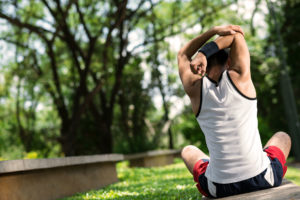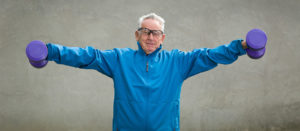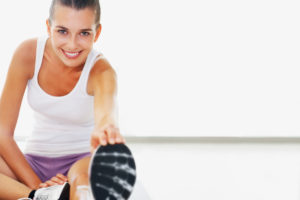Flexibility
Chronic Pain in Fitness Professionals
An Objective Eye
It can be difficult to take a step back and be objective when it comes to your own health. Katy Bowman, MS, director of the Restorative Exercise Institute in Ventura, California, and author
of Move Your DNA: Restore Your Health Through Natural Movement (Propriometrics Press 2014), suggests you write down
the following:
Stretching For Men
Many men struggle with inflexibility and diminished joint range of motion, especially as they age. Hip tightness, for example, can hinder athletic performance and possibly lead to various injuries. Unfortunately, stretching often takes a back seat to cardiovascular and strength training.
Five Benefits of Eccentric Exercise
Not everyone likes to focus on eccentric contractions, but this style of training deserves more attention because it may be a “secret weapon” for creating healthier joints and a long, lean body. Research reveals the perks for newcomers and well-trained athletes.
Self Myofascial Release for Seniors
Did you know it’s important to take care of the fascia—or connective tissue—in your body? The health of connective tissue is a serious concern for older people, as movement restrictions can make it hard for them to perform simple activities of daily living. The condition of our connective tissue depends on two factors—how old we are and what we have done in our lives to keep our tissue healthy, hydrated and flexible.
Rehabilitation Breakthroughs With Eccentric Training
A recent special edition of the Journal of Applied Physiology focused on eccentric training, best defined as using active force to produce muscle tension while the muscle is lengthening.
Prehabilitation Strengthening Exercises for Knee and Hip Arthroplasty
Fitness professionals may work in concert with a physical therapist to encourage a client to engage in “prehab” to maintain or enhance his strength preoperatively for knee or hip arthroplasty. (Shakoor et al. 2010). Pain is often a limiting factor, and it may be difficult for the client to participate in even the most basic daily activities. Below are a few suggested exercises.
KNEE ARTHROPLASTY
Isometric quadriceps sets. Lie on back with legs extended. Tighten quads and push knee into mat/surface. Hold 10 seconds. Do 10 repetitions, 5 times per day.
Sun Salutation Solutions
Traditionally performed in the morning to greet the new day, the yoga sun salutation series warms up the body and prepares it for practice. While this flow successfully targets large muscles and brings the mind to a singular focus, it does so primarily in the sagittal plane. When you add movements that address the frontal and transverse planes, sun salutations become a functional warm-up for any class, including circuit, step, dance and strength. Bare feet are not required!
Roll Out to Warm Up
If you’re looking for a fresh, effective way to help your group participants move better, why not include foam rolling in your next class? Chances are some of your attendees are curious and could use some guided instruction.
This simple foam roller warm-up uses self-myofascial-release (SMR) techniques to warm up the fascia, allowing tissues to move more freely. Trauma, irritation, repetitive use and a sedentary lifestyle create stiffness and can shorten the muscles and/or fascia. A few minutes of SMR offers many benefits.
Introducing the GYROTONIC® Method to Pilates Instructors
As movement teachers, we’re eager to learn more about how to live comfortably in our bodies. How can we transfer this ability to our clients and students?
Sit-to-Stand Predicts Mortality in Older Adults
A person’s ability to get up from the floor may be a predictor of mortality, according to researchers from Clinimex Exercise Medicine Clinic in Rio de Janeiro.
The study, published in the European Journal of Cardiovascular Prevention (2012; doi: 10.1177/2047487312471759), examined information from 2,000 adults, aged 51–80, from 1997 to 2011. Participants were asked to perform what researchers termed the sitting-rising test, a useful assessment of musculoskeletal fitness. Anyone currently playing sports or presenting with musculoskeletal limitations was excluded.
Cool Down With the Stability Ball
Using the stability ball for cool-down stretches provides many benefits over traditional stretching. The ball’s reactive properties make stretching more dynamic, since balance, coordination and body awareness depend on certain muscles stabilizing while others stretch. Participants can modify moves by simply rolling deeper into the stretches or pulling back from them.
Pilates Exercises Improve Back Health
Many clients come to you with low-back pain, a condition that affects 80% of Americans. In contrast, chronic low-back pain—defined as persistent pain and disability lasting longer than 3 months—affects approximately 2%-8% of Americans.
Spotlight on Stretching
Do you want to enhance your workouts and activities of daily living? Then improve your flexibility through stretching! To help you understand how to stretch in a safe, effective manner, Len Kravitz, PhD, program coordinator of exercise science and a researcher at the University of New Mexico, Albuquerque, shares guidelines and strategies for stretching.
How to Handle the Hypermobile Client
Many Pilates clients fight to increase their flexibility. Some struggle to touch their toes, for instance, while others work hard to stretch their shoulders and some are barely able to sit cross-legged. But how do you handle the ones who are as pliable as Play-Doh and fight just to hold themselves in place?
What methods do you use to enhance flexibility in clients?
Our personal training studio primarily serves new exercisers or people who have not exercised for a while. Consequently, we require virtually all new clients to schedule an initial fitness assessment prior to exercising with us. During that assessment, flexibility (among other things) is evaluated and problem areas are identified. Commonly, these include the shoulder girdle (especially traps), lumbar region, hamstrings, hip flexors, glutes/hips and calves.
Our general rules of thumb for training flexibility in clients include the following:
Flexibility Differences Among Men and Women
When it comes to flexibility, women rule. So says a recent study published in the Journal of Strength & Conditioning Research (2010; 24 [10], 2618–26). The subjects included 13 men and 19 women who performed stretch tolerance tests to determine musculoskeletal stiffness and ankle range of motion. They then completed a stretching protocol that included 9 repetitions of a passive stretching exercise, with each rep held for 135 seconds. According to the results, the women experienced improved range of motion following the stretch interval, but the men did not.
Pre-Run Stretch Hampers Endurance
Here’s another entry in a growing list of studies that suggest that pre-exercise static stretching may hamper athletic performance. This current study, published in the Journal of Strength & Conditioning Research (2010; 24 [9], 2274–79), included 10 male collegiate athletes who participated in a 60-minute treadmill run on two occasions. One run took place after 16 minutes of static stretching of the major lower-body muscles; before the other run, participants simply sat quietly for 16 minutes.
Strength Training Best for Flexibility?
Flexibility improves range of motion and reduces wear on soft and hard tissue. Much research has emerged touting various best practices to improve flexibility. A study presented recently at the…
Tips for Flexibility Training
When it comes to the Big Three of exercise–cardiovascular, strength and flexibility training–it’s pretty clear which one can get overlooked. After all, while we prize cardiovascular and strength training for their role in helping us lose weight, build muscle and get fit, the benefits of flexibility training are less immediately alluring.
However, as the population ages, more of us ar…
10 Tips to Better Balance
When we’re young, we generally take our balancing skills for granted. As we get older, however, we find that our balance (the ability to sense where our bodies are positioned and adjust muscle tension to maintain alignment) isn’t what it used to be. The consequences of losing our ability to balance are significant. Falls are the leading cause of injury for older adults. Every year, 30 to 50 percen…
- « Previous
- 1
- 2
- 3
- 4
- Next »













